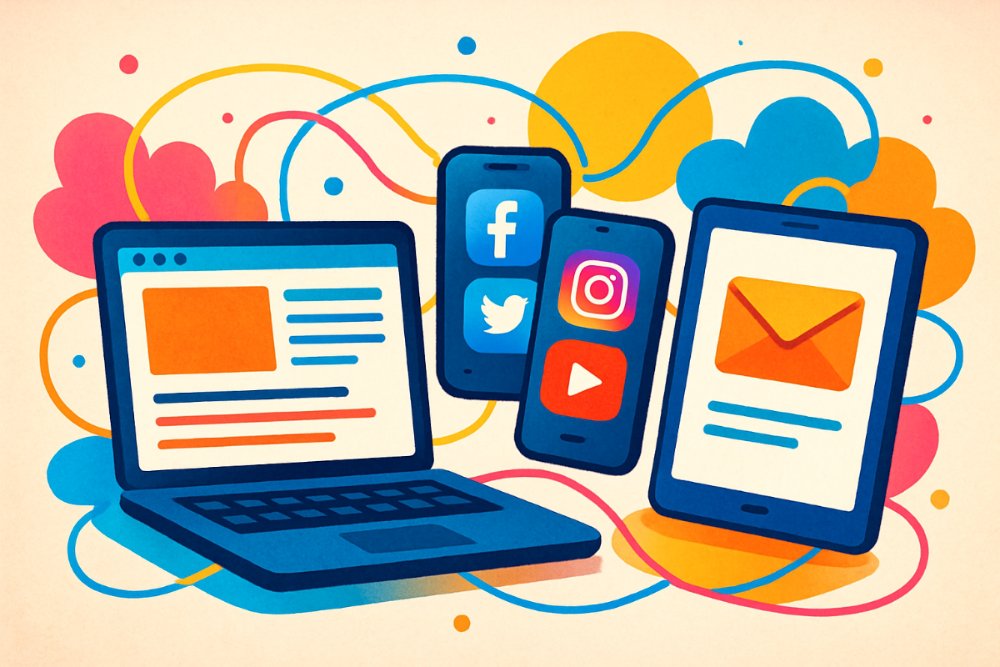Effective communication with customers is fundamental to the success of any business aiming to foster strong relationships, enhance brand loyalty, and stimulate sustainable growth. Leveraging a comprehensive array of digital channels—such as websites, social media, email, and advanced technological tools—is critical in ensuring your message consistently reaches and resonates with your intended audience. This expanded guide explores detailed strategies to optimize communication across various channels for maximum impact.

1. Deeply Understanding Your Audience
Effective communication starts with an in-depth understanding of your customer base. Utilize surveys, analytics tools, and direct customer interviews to gather detailed insights about demographics, purchasing behaviors, preferences, and pain points. Personalization based on these insights can significantly enhance customer interactions, building trust and engagement. Regularly revisit and refresh your understanding as market trends and customer behaviors continually evolve.
2. Crafting an Optimized User-Centric Website
Your website often forms the initial impression of your business. It should be intuitive, easy-to-navigate, and rich in accessible, relevant content. Optimize for mobile devices, given that many customers access websites predominantly via smartphones. Ensure contact information is prominently displayed, and include real-time assistance options, such as live chat, to promptly address customer queries. User experience enhancements boost credibility, reliability, and customer satisfaction.
3. Harnessing Social Media Effectively
Social media is indispensable for engaging customers on a personal and interactive level. Select platforms that align best with your customer demographic, such as Instagram, Facebook, LinkedIn, TikTok, or Twitter. Maintain consistent branding across these platforms to strengthen brand recognition. Regularly interact with followers by responding quickly and genuinely to comments and messages. Cultivate a sense of community through active engagement, ultimately fostering deeper relationships and trust.
4. Refining Email Marketing Strategies
Email remains a powerful and direct channel for customer communication. Develop concise, compelling emails with clearly articulated calls to action. Employ personalization techniques, leveraging customer data to deliver tailored content. Segment your subscriber lists to ensure targeted and relevant messaging. Regularly assess performance metrics like open rates, click-through rates, and conversions to fine-tune email campaigns for optimal effectiveness.
5. Utilizing and Responding to Customer Feedback
Customer feedback provides invaluable insights into how your business communicates and interacts with its audience. Actively encourage and solicit reviews, testimonials, and detailed feedback through surveys or feedback forms. Use the collected information to refine communication strategies, enhance customer service practices, and shape product or service improvements. Demonstrating responsiveness to feedback reinforces customer loyalty and satisfaction.
6. Developing Engaging, Value-Driven Content
Creating valuable content is pivotal in capturing and retaining customer interest. Diversify your content strategy to include blog articles, videos, podcasts, infographics, and webinars to cater to various consumer preferences. Prioritize quality content that educates, entertains, or provides actionable insights. This approach positions your brand as an authority in your field, driving customer loyalty and advocacy.
7. Integrating Chatbots and AI Effectively
Utilizing advanced technologies like chatbots and artificial intelligence enhances customer communication by providing immediate responses to common inquiries, significantly improving the user experience. Ensure chatbots are intelligently programmed to handle routine questions seamlessly and escalate more complex issues to human representatives efficiently. This balanced integration maintains efficiency without sacrificing the personal touch critical to customer satisfaction.
8. Comprehensive Monitoring and Analytical Review
Regular assessment of your communication effectiveness through detailed monitoring and analytics is crucial. Leverage tools such as Google Analytics, customer relationship management (CRM) software, and social media analytics platforms to gauge engagement levels, conversion rates, and overall communication impact. Use this data-driven approach to adapt strategies proactively, ensuring they continuously align with customer needs and evolving market conditions.
9. Investing in Customer Service Training
Superior communication also heavily depends on skilled customer service representatives. Regularly train and empower your customer support team, focusing on essential soft skills like empathy, active listening, clear communication, and problem-solving capabilities. Equip your representatives with comprehensive knowledge about your products and services, enabling them to resolve issues efficiently and effectively. Excellent customer service directly translates into increased customer satisfaction and stronger brand loyalty.
10. Creating a Cohesive Cross-Channel Communication Strategy
Consistency across all communication channels is critical to preventing customer confusion and building a robust brand identity. Develop a cohesive strategy that integrates messaging, tone, visual identity, and engagement tactics consistently across your website, social media, emails, and customer service interactions. This unified approach reinforces brand strength, customer recognition, and trust, facilitating smoother, more productive interactions with customers.
11. Embracing Emerging Trends and Technologies
Stay ahead of communication trends by continuously exploring emerging digital tools and technologies. Innovations such as virtual reality (VR), augmented reality (AR), voice technology, and advanced data analytics are transforming customer engagement opportunities. Incorporating these advanced tools strategically can significantly enhance the customer experience, showcasing your business as innovative and customer-centric.
12. Maintaining Authenticity and Transparency
Finally, authenticity and transparency are foundational elements in customer communication. Be honest, open, and direct in all interactions. Clearly communicate business values, policies, and changes promptly and transparently. Customers value authenticity highly, and maintaining transparent communication builds enduring trust and customer loyalty.
Conclusion
Effective communication with customers is dynamic and continually evolving, requiring ongoing adjustment and improvement. By deeply understanding your audience, strategically utilizing digital platforms, creating diverse, valuable content, and integrating advanced technologies, your business can cultivate meaningful, lasting customer relationships. Embracing these detailed strategies ensures your communication remains impactful, fostering greater customer loyalty and sustainable business growth.